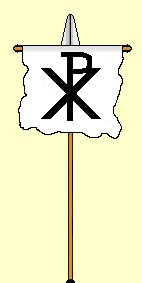

The labarum was a Christian battle standard in the form of a pennant upon which was displayed a Christogram. The Christogram was the Greek letter X (Chi) superimposed on the letter P (Rho) and was the monogram for Jesus Christ’s name. The chi and the rho, are the first two letters in the Greek word for Christ. The pennant was square and hung down from a short horizontal wooden arm. This arm was placed atop a tall wooden staff so it could be seen by the soldiers above the confusion of battle.

Another variant was a long spear, overlaid with gold, with a transverse bar forming the figure of a cross. From the crossbar of the spear, was suspended a purple banner with the Greek inscription TOUTO NIKA which translates as: conquer by this (sign). This banner, square in form, covered with a rich embroidery of precious stones and richly interlaced with gold, presented an indescribable degree of beauty to the beholder. On the top of the whole was fixed a wreath of gold and precious stones, and within this the Chi-Rho. Fifty soldiers of the imperial guard, distinguished for bravery and piety, were entrusted with the care and defense of the new sacred standard (Vita Constant II:8).
According to legend, Constantine I "The Great" had a dream the night before a decisive battle at the Milvian Bridge in 212 AD. In the dream, Jesus appeared to Constantine and said to him "In this sign shalt thou conquer!" (IN HOC SIGNO VINCES) and Constantine immediately had the sign emblazoned on his legions’ gear and won the battle. This symbol came to decorate the standards of Roman armies from that time on. The labarum gradually came to replace the very individualistic vexillum, which was a battle standard that was different for each legion. Its presence on a coin signified that the army was a Christian one. Due to the dream of Constantine the Christogram is also known as the monogram of Constantine, so called, not because it was the invention of this emperor, for it had been a familiar Christian symbol prior to his conversion, but because of the great popularity it enjoyed from the date of its appearance on the imperial standards. In form, the labarum of Constantine was an adaptation of the already existing cavalry standard of the Roman army, the pagan emblems were merely replaced by Christian symbols. The term labarum, which is of uncertain derivation, was probably familiar in the Roman army from the reign of Hadrian.